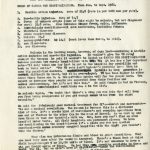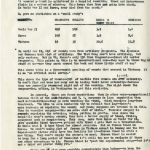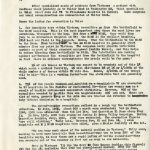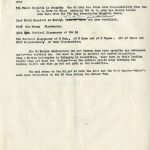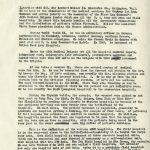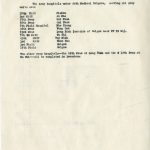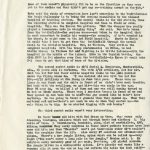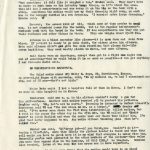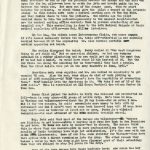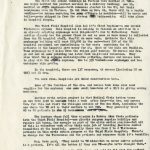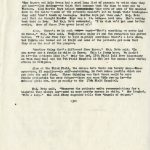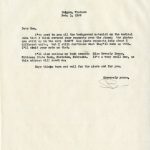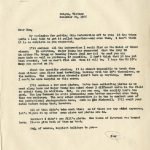1966, August, “Medical Interviews”
Ron:
I’ve broken down the interviewing and the typing of the interviews into several sections:
1. An over-all MACV medical briefing.
2. Out-of-Country evacuations
3. 44th Medical Brigade which handles US Helicopters ambulances and all Army hospitals.
4. U. S. Army nurses and combat medics.
5. Re-typed a mecial article from a US Army magazine.
6. Photostats of several US Navy articles on hospital ships.
7. Some statistics from MAC-v. (These actually are sent down from the Pentagon).
We are still trying to find a big brocure brochure on the 45th MUST hospital, which is the newest thing. I’ll get it off to you as soon as MACV can find it.
We don’t have much in the way of photos–please let me know what you want to do about that; I suspect the IO’s here can come up with something.
Please give my best to Jill and Dean–tell Jill I haven’t forgotten about her dinausaur-I’ve had it wrapped for months, but have yet to find anyone to APO it.
My bank account is: Beverly Deepe, Citizens State Bank, Carleton, Nebraska. Please send the money there.
Thanks alot; please keep in touch and best of luck.
Bev
1. MACV Briefing
INTERVIEW WITH COL. GERALD A CHAMPLIN, DEPUTY SERGEON: attribution should not be made to him personally, but can attribute to U. S. medical authorites, U. S. military sources or to the MACV Surgeon’s office.
This is the “big picture briefing,” about U. S. troops and their medical support.
“Most armies in this part of the world are decimated more by disease than by combat injuries–such diseases as malaria, hepeititis and sleeping sickness.” Malaria ranks no. 7 as a cause for admission to and military hospitals–bu is no. 1 in work-days lost because it takes 30-35 days to recover from malaria.
The current malaria rate, for Oct. ’66, is about 30 per 1000 per year–this is the medical rate commonly used, which means if 1000 troops were held in one place for 1 year, 30 would get malaria. The worst period was Nov. ’65, when the rate was 50 per thousand per year. This rate is pretty meaningfless however, since many of the units outside of the central highlands do not get malaria.
On the new pill, DDS–“there’s a hooker in this–only the units exposed are on DDS–these units are in the central highlands, which is the bad malaria place.” He said they aren’t finding malaria in great quantities|there–but he refused (said he didn’t have) the rate of malaria for these specific units in the highlands, such as First Cav, 25th Div. Brigade etc.
He said the rfefugees from Viet Cong areas are heavily infected with malaria.
In Oct. ’66, there were 870 malaria cases throughout Vietnam, but this includes Army, Air Force and Marines–including civilian contractors. This is country-wide total.
On DDS, “It is not a cure-all–will reduce malaria by 50 percent of the indcidence. I think our malaria rate is down as much because of command emphasis as by drugs–the comand emphasiszes things like rolling down shirt sleeves after dark, spraying with insect repellents etc. They are doing alot of spraying from the air too. The Cp-123’s can sprayx1000 10,000 acres in an hour–they once sprayed a whole valley twice where Vietnamese training camps were based and the disease rate wient down alot.”
Of the 870 malaria cases in Oct. ’66, most of them were in the First Cav, 3 Brig. 25th Div. and the new 4th Infantry Divsio Divisoion–all of which operate in the Highlands.
In the sSouthwest Pacific during World War II, the U. S. Marines had 3000 men per 1000 per year who got malaria, he said–that is if 1000 men were put in one place per year, three each would get malaria three times–i. e. the malaria incident rate was so high. (RON: I SUGGEST CHECKING THESE FIGURES IN WASHINGTON; I’VE HEARD A DIFFERENT WORLD WAR II RATE USED AND THIS ONE SEEMS TOO HIGH).
2.
MACV has confirmed that three types of malaria exist–and possibly a fourth.
ORDER OF CAUSES FOR HOSPITALIZATION. From Jan. to Sept. 1966.
1. Hostile action injuries. rate of 91.8 (rate is per 1000 men per year).
2. Non-battle injuries. Rate of 74.7
3. fever of unknown origin (some of this might be malaria, but not diagnosed for sure) 55.8 rate. Also includes deingue fever, colds, influenza.
4. Demrmatologic conditions–all skin conditions, including fungus.
5. Diarrheal diseases
6. acute respiratory diseases
7. Malaria 25.7
8. neuropsychiatric 15 14.5 (Much lower than Korea, he said).
9. eye disorders
10. ear diseases.
Malaria is the leading cause, however, of days lost–excluding n hostile action injuries and non-battle injuries. He wouldn’t give the VD rate; amongst the troops; he said it wouldn’t be listed as CAUSES FOR HOSPITALIZATION because persons are rarely hospitalized with vd;x VD; it has a low days-lost rate–“it only takes one day lost to get to the hospital for penicillin and back to their units.” “The VD rate isn’t bad–it’s probably lower than in some big population centers. Syphilliuwn Syphl Syphilis is low; gonorrhea is diffifi difficult to treat, but it is over-pelayed. VCD has been higher in other areas where there are U. S. troops–this speaks well for the people here. You expect an increase when people are separated from their families and normal surroundings. But it’s not that bad.” He said fungus is baad in Vietnam, which makes deormatological conditions no. 4 in the list.
On malaria again, “We doubt that there’s a drug you can take that will keep you from being overpowered if you get enough mosqu bites from the right mosquito.”
He said the fabulously good medical treatment for GI’s–combat and non-combat–“is not a medical revolution. The reason is because this is a different kind of war. It’s a static kind of war–there’s not sweeping operations from one end of Vietnam to the other (as in the case of Korea). As we went up and down Korea we took our hospitals with us. But, here you can’t find an evac hospital under tents. All field hospitals are permanent places. We have air conditioning in the hospitals–so it’s a place you can use special anesthesia–in order ordinary surgical hospitals with the diret you wouldn’t take the chance.”
They also use intravenous fluids and blood in great quantities. They are used very soon after the wound is incurred. There’s a Blood Bank at third field hospital–get 9 or 10,000 units of blood. It’s not uncommon to have a wia get 50-100 units of blood. We had this quna quantity available in Korea and World War II, but we didn’t have it distributed–again the relationship to the hospital being clustered in with the fighting men.
3.
“A wounded patient is splintered and in a hospital recieving blood and intravenous fluids in a matter of minutes. This keeps them from got going into shock. In World War II and Korea, many died from the shock.”
He gave me statistics on a “small study”:
WorldxxWar FRAGMENTS BULLETS MINES AND BOOBY TRAPS GRENADES
World War II 61% 18% 3.1 1.6
Korea> 50% 27 3.9 8.0
Vietnam 19 35 20.6 15.7
“In world war II, 61% of wounds were from artillery fgragments. The Japanese and Germans used alot of artillery. The Viet cong don’t have artillery, but only mortars. But in VN, there’s only 19% from fragments–almost all mortar fragments. This points up this is an unconventional war–they used to throw big st stuff at us–now they sneak around the back and throw little stuff at us.”
This above table is a three-month sampling of wounds that occured in Vietnam; it is an “an official small survey.”
This shows the type of wounds–50% of hostile fire wounds are owerlower extremity. We can’t find out here how many end up losing their lower extremity–because they are generally evacuated right out of the country. You might check the Surgeon-Gen. office, in Washington to get this statistic.
In general, there are fewer amputations than in other wars–proportinally because first of the aniti-biotics and U. S. surgeons do less amputation than most nationalities–they go into breeding the wound, which requires long-term treatment. “We like to save limbs–we try to rebilt that leg–there’s more emphasis on repairing the wound; our young surgeons are trained to do this. They do vascular surgery–this as saves alot of limbs.” Vascular surgery is reparig repairing the arteries, veins, putting in grafts. Also since the hospitals aren’t moving around, they have a better supply of blood, fluids, euipment such as respirators. They now, more than Korea or World War II, give spicific blood types–a patient with blood A gets that as a transfusions. In Korea used x O type blood for almost everyone. Had no frozen blood in Repose–only places still have the facility for it–frozen blood is still a new thing. They can’t suppy the amounts we need. Frozen blood is easier to keep for a long period of time–but it’s still too new to evaluate if there are other avantages to it. Frozen blood is “past the experimental stage–but it’s not a tried and proved thing yet.”
Tehre are ai also more portable rescuitators than before–to keep the air supply moving freely–some corpsmen carry it–more than they did in Korea.
4.
In Korean War, they started using the h-13 ho. putting pods on the saidside, or as Mt spokesman described it, “A medical basiket on the runners like a little coffin.” Sometimes used the light airplane L-5 with room for one or two liters litters in it.
-30-
Out-of-Country Evacuation
Second interview with MACV surgeon
Out-of-Country Evacuation.
Interview with Col. Gerald A. Champlin, deputy surgeon, MAC-V Surgeons office; attribution should not be made to him personally, but to US medical authorities or US military sources or to the MACV Surgeon’s office.
Also interviewed Maj. Daniel E. Tully, medical regulating officer, jmajor, Medical Service Corps, from San Pedro, Calif. He handles the evacuations from H US hospitals in Vietnam out of the country.
First part of this interview with Champlin–not for personal attribution.
On lfew amputations–in nearly all cases the surgeons do more vein grafts. if a major artery or vein is wounded or damaged, they put in a tube–also the patient gets blood faster than before, which helps save the limbs. In other cases, the hospitals have more equipment and medical supplies of greater sophistication–i. e. have artificial kidneys on the USS Repose; have a machine in which the blood can be shuttled around the heart while heart is being repaired.
In addition to the Mobile Army Surgical Hospitals (MASH)–on the Army side–(see next interview for listing of them) the U. S. Marine Corps in II Corps has Marine Companies or a medical battalion in Hue, Danang and Danang East. In addition, there is a H U. S. Air Forcethe 12th USAF Hospital in Cam Ranh Bay–but they call it a convalescent center, of 1000 beds, mostly for malaria and other long-term medical diseases, rather than combat wounds. Also treats hepatitis.
The MACV regulating office also has responsibility for Thailand.
The MACV offices keep track of the no. of beds occupied and available in each hospital in the contry on a daily basis; if one hospital is getting too full, then the patients are evacuated elsewhere either in or out of VN, depending on length of time estimated for him to be ready for combat again. This office can send patients also to the USSRepose; the USS Sanctuary is due first of 1967 in VN waters and there will then be two hospital ships on station near VN.
On the overage 100 US patients are evacuated out of Vietnam to other US hospitals in the Pacifi or US on a dialy basis; but during the Op. Attleboror in Tayninh 160 were evacuated out on some days.
The ov points for aero-medical evacuation out of VN are Danang, Chu Lai, Qui Nhon, Nha Trang, Cam Ranh, Saigon. Casualties from Pleiku or An Khe are sent to Qui Nhon or Nha Trang for out-of-country evacuation. Those casualties in Bien Hoa, Cu Chi, Tayninh come to Saigon for evac out of VN. These staging points for evacuation out of VN hold the patients for 24 hours bfore the evacuation.
For out-of-country evacuations there are scheduled seven scheduled flights–one day–as normal, but more can be scheduled if needed; all go straight to USAFxComm3rdcmm Cal Clark AF Base on the USAF 903rd Evacuation Squadron; others go on to US; on Tues. Thurs, Sat and Sun, flights take the patients to Japan and some from there onto US.
2. “Everyday we get a call from Jpa Japan–I’m a branch of the Far East Joint Medical REgulating Office,” Tully Said. (they handle all casualties–army, navy, air force and marine.) “They give us the umber of bed credits in Japan, Okinaway, Then we know where to send our patients.”
Hospitals backing up Vietnam, where VN casualties are sent to are: two USAF hospitals at Clark and Tachikawa, Japan; six US Army hospitals–four in Japan, one i in Hawaii (Tripler) and one in Okinawa; the four Army hospitals in Japan are the 7th Field Hospital; 106th General Hospital; 249th General Hospital and one in z Zama. The|two Navy hospitals to which US patients from VN are sent are on Guam and at Yokosuka, Japan.
“Thisxkeyxtomxthexsystem “This (office) is the key to the systmeem (of out-of-country-evacuations), Tully said. “This tells us how many beds (there are in eachhospital) and wthe specialists that are available (in each hospital).” Hence, for exmap example, they know that one hospital specializes in plastic surgury or has iron lungs; patients requiring these specialities are sent there. Maxillo facial wounds, for example, go to one hospital; amputations go to Tripler, the 106th or the 249th. The office tries to ecac army patients to army hospitals; air force to AF hospitals etc–as a general rule–but if an AF casualty needs a specialty provided by an Army hospital, he is sent to an Army hospital.
Each of these hospitals throughout the Pacific calls the Japan office of the Far East Joint Medical Regulating Office and then the Japan office coordinates this and calls Vietnam as to where patients|are|to be sent; Vietnam also informs Japan about no. of patients and special care they demand.
If a patient can be cured and returned to duty in 30 days, he’s held in Vietnam. He can be moved from one hospital to another for sspecial treatment–for example, the Third Field Hospital specializes in plastic surgury for facial wounds. But this in-country evacuation is handled by the 44th Medical Brigrade, USARV.
within the Pacific backing up Vietnam the Army has 4150 beds; Navy has 1077 beds; Air Force has 5 650 beds. All of these beds are in the Far East arexare and are capable of taking US casualties from Vietnam. The patientsa are evacuated to Pacific hopitals if it will require 30-120 days for the patient to recover; if recovery will be a long-term affair and the patient can not be returned to duty and the special medical care is not available in the Pacific, he can then be transferred to Continental US. For example, severe burn cases are sent to the Brook Army Hospital in Ft. Sam Houston, Tex. These are flown directly from VN to Fort Sam Houston via the Starlifter USAf aircraft, via Travis AF Base Calif. These aptie patientsas are flown direct to US on the same plane all the way; there is no off-loamding unless the patient needs immediate care. Each patient is given as much individual care as possible.
If a patient has amputations and will not be returned to duty, for example, and will get fitted for artificial limbs, then the Far East office in Japan or in Saigon can call the Armed Service Medical Regulating Office in Washington DC, they give the Washington office all the necessary medical information, includng the nearest hospital to the patients home-town, h and he will be sent there. This is almost individualized pallacement in the US–this is handled directly Saigon-Washington telephone communications.
3.
Other specialized needs of patients from Vietnam: a patient with deafness would probably go to Walter Reed in Washington DC, which specializes in this; chest care and TB to Fitzsimons Hosptial in Denver; hand surgeons and renal reconstruction are concentrated at Walter Reed.
Hence the ladder for evacuation is this:
1. for immediate care within Vietnam, casualties go from the battlefield to the MASH hospital. This is the most important step where the most lives are saved–hc. transport is the key. But from a MSAH MASH, they would then jump to an Evacuation Hospital in VN; the MASH is the smallest hospital, EVAC next and Field is the largest. Hence, from the battlefield to the MASH to the Evac. From battleifledfield to the ev MASH hospital is generally 15-25 minutes from any point in Vietnam. The corpsmen carry plastic inflatable sprints as part of their standard equipment (unlike Korea), and this helps to reduce bleeding from battlefield to MASH. The “statistics are working against us–because the casualties get from he battlefield to the hospital so fast where in ordinary circumstances the people would be far gone.”
1% of all troops in Vietnam can expect to be wounded; and of this 1% which reach a medical facility, 1% will die–hence 1% of 1% or 1/100th of the whole number t of troops within VN will die. Hence, 1/100th of the troops will be kia–“This is a working factor”–or the statistics that are generally used.
2. 75% of the people wounded and admitted to a hospital in VN are evacuated to US hospitals in the Pacific or continental US–these are wounds are as a result of hostile action–not non-combat statistics. However, 60% of the casualties wounded by hostile fire are hospitalized; 40% are not. There are alot of cuts, grenade gfrag on the skin who are treated and returned to hospitalmm duty without admission to a hospital.
The out-of-couintry evacuations reflect in a rough way the battlefield situation. In July, 1965, about 900 a month were evacuated; but in June, 1966, 2500 were efvacuated when the 1st Div. had Operation El Paso along Hway 13. In Nov. 1965, 2000 were evacuated during Ia Drang Valley campaign. During Operation Prarie, July, 1966, 2500 were evacuated. The evacuation figures “are still climbing,” Tully said. Between Nov. 65 and Nov. 66, 3 evac hospitals and M 3 MASH hospitals were added, plus a Marine facility in Chu Lai.
“We are very much ahead of the medical problem in Vietnam,” Tully said, meaning we have more hospitals than casualties–they try to keep 50% of the hospitals empty, in case there are a rapid influx of battle casualties–they can evacuate out of the country as fast and as many as are necessary.
Beds in Vietnam: 735 for the Navy Ot (the Repose doubles this figure); 215 for the AF, excluding that 1000 bed convalescent center; 2805 for the Army. (The Navy is support for the USMC). The N USAF convalescent center in Cam Ranh bay is for treatmontmom convalescence–not treatment. They try to kee 1/2 of the beds empty–it is 70% occupied now.
4.
MACV also handles Thailandm U. S. medical facilities in Thailand. They are:
5th Field Hosptial in Bangkok; the US Army has taken over responsibility from the U. S. Navy on this; actually the U. S. Army has simply leased some beds from the 7th Day Adventistsx Hospital there.
31st Field Hospital in Korate. Both of thesethis and the 5th Field are ARmy contolled.
USAF Don Muong Dispensary.
35th Tacx Tactical Dispensary at Tak Li
8th Tactical Dispensary at U Bon., at U Dorn and at U Tapao . All of these are USAF Dispensaries. or Army dispensaries.
The US Marine helicopters are not brokend own into specific air ambulance units–the tactical hc. are used to pick up medical and combat casualties. When a Marine helicopter is bringing in casualties, they turn on their landing lights when get near the helioport–so he medical people keep watching for landing lights and then go out and pick up the casualties.
The med evacs to the US got to both the East and the West coasts–there’s much more evacuation to the US than during the Korean War.
U.S. Army Hospitals and H.C.
Interview with Army’s 1st Logsitics Command representative
3. U. S. Army Hospitals and H. C.
Interview wtith Col. Ray Lambert Miller (S. Dinwiddie St., Arlington, VA.). He is head of the directorate of the medical services for the|Army 1st Log. Command and serves jointly as the commander of the First Log Command’s 44th Medical Brigade (under which are all the U. S. Army med evac and field hospitals. In short this brigade handles all the in-country evacuations and the distribution of patients within Vietnam.). Miller was assistant White House physician during the Truman Administration.
During World War II, he was an arrtillery officer in Europe, participating in Normandy, Ardennes, central Germany, northern France, Rhineland and Italian campaigns. He holds the French Croix de Guerre with gold star and U. S. Army Commendation Medal. In 1949, he interned at Walter Reed Army Hospital.
Under the 44th Medical Brigade are all the hospital medical depots, laboratory work, helicopters (air ambulance), preventative medicine and dental–have more than 100 units in the brigade with 7000 peronn personnel in the Brigade.
If one takes a wounded GI, there are several routes of medical care for him. 1. He can be evacuated from the forward aid station to the div. by hc–or the hc., if he’s serious, can overfly the div. clearing station and carry him directly to the nearest hospital. 2. Or he may go from the aid station back to the division clearing station, if he’s not too serious. The most forward hospital is the MASH, where they stop bleeding so can be evacuated to the field hosptial where he the patient can get definitive care. Or he can overfly the MASH (surgical hospital) to the evacuation hospital.
During the Tayninh battle, for example, the wounded were picked up and then sent to Vung Tau, Tay Ninh, Cu Chi, Saigon, Long Binh or Bien Hoa–the flexibility in sending the patients to fvarious hospitals is because of air ambulance hc–they can move freely from the battlefield to the hospital In most cases, the patient movement is regulated, generally to preclude one hospital getting a backlog, for exmaple of four hours, of patients; if this happens the patients are shifted to another hospital. In addition, the hospitals nearest the front are regulated to be sure that the hospital and the beds are as free as possible, with the patients being moved to the rear just in the event something some big inflow of patients develops.
This is the definition of the various ARMY hospitals. The field hospital is in the rear–not close to the battlefield–clasically it is behind the corps rear area. Each field hospital is composed of three separate hospital units, which can be separated and sent forward if necessary as a self-contained unit. Each hospital unit has 100 beds. The 8th Field hosptial in Nha Trang, for example, th cam into Vietnam w in 1962 and was called a field hospital, but actually had only one hospital unit of 100 beds; today it is a genuinie field hospital with hthree hospital units. The surgical hospital (called MASH) has 60 beds; it has more surgeons than any other type of medical personnel; it is mobile (classically) and is able to follow the troops. The mission of the MASH is to get a patient and to prepare him for movement to the rear.
2.
The surgeons do not do detailed surgury–they give blood, patch chest wounds–then patient is sent to evac hospital, which is much more sophisticated and can provide definitive care, such as sewing up intestines–more detailed surgury. The evac hospital has 400 beds.
The field hospital can provide emergency surgery, but in general it is more medical than surgical–this is the classical distinction. But, these classical distinctions “don’t work here,” Col. Miller said because the hc can put a patient directly into evac or field hospital from the battlefield, if the case warrants it.
The above diescription worked in Korea and World War II; there were not MASH hospitals in World War II–they first came in Korea, but there weren’t as many MASH hospitals in Korea as in Vietnam. The MASH in Korea was truly mobile–in Vietnam they aren’t. H “Here we are fighting a mobile war from fixed medical bases–the hospitals aren’t tents; the field c and evac hospitals are in quonsets, which are air-conditioned and dust-proof. We have augmented them with much more sophisticated equipment–which one would ordinarily have with a US hospital–equi0pment such as a pace-maker, which stimulates the heart; or another apparatus which shocks the heart into a regular beat when it is chaotic, or respirators which breathe for the patient when he is unconscious. Hence, from this fixed medical base we can do Statestide medicne.” The reason the mobile hospitals can be fixed in Vietnam is “the country is narrow–this is not a war in depth with a solid frontline, as in the case of Germany. The air ambulances within 15 to 45 minutes can have the patient in the nearest hospital; we have hospitals in mosst places. We can provinde the patient with the most sophisticated medical care ever provided in a theatre of war.”
There is also a 1000 bed convalescent center in Cam Rahn–but they do not consider it a hospital; it takes care of malaria where the treatment is continued.
The malaria patients are put into three categories: Category 1 means confined to bed; Category 2 meaning ambulatory; they get light physical trainging and Category 3–“The tiger company,” in which they get intensive physical therapy, swimming; one-mile run and then they are ready for combat during.Again.
ON THE HELICOPTER–The heart of the medical program is the hc. “This is the agency that gives us flexibility to this or that hospital in a fixed position . The hc. is the distribution means to shift casualties|around fast. Through the use of the hc., we can divert casualties from one particular hospital to another. In world war II, we had only ground ambulances.”
It is important to remember that the hc–first in co Korea–and then the UH-1 was developed first at the request of the Surgeon’s Office to fulfill medical requirements–then later the hc. was used as a tactical weapon by thef commanders of fighting units. But, the medical branch first envisioned the hc. for medial casualties.–this was true of the H-13 in Korea; the 1st Hueys in Vietnam were med evac. Hc.’s
3.
In 44th Medical Brigade, there are two air ambulance companies plus another air ambulance company that is organic to the 1st Air Cav Division, that is attackhed to the medical battalion.
In the 44th Medical Brigade, all the crew, pilots and co-pilots are supposed to be medical aid men–i. e. they have advanced first aid; the officers have a medical service corps background. The hc. crews can and do give in-flight care to the patients enroute to the hospitals; the hc. carry blood. The medical aid men can to simple things like applying bandages, splints–he advises the hc. ppilot in-flight about the seriousness of the patients–then the pilot might divert the plane aircraft to a closer hospital etc.
The chief of a hospital or a hospital division are regular army officers; but the non-chiefs can be two-year doctors in various stages of training; some of these have finished all their medical training and internship on the civilian side; some are specialists and these doctors are given more responsibility. Some of the nurses are army careerists; others came over under two-year program, in which the nurse specifically volunteers for Vietnam for one year. One nurse volunteered for Vietnam to be with her husband, for example, but by the time she got here, her husband had gone home.
In another case, two male majors, in thirties and forties, who had finished their medical school and had civilian practices, volunteered for active duty, specifically requesting Vietnam. ONe decided to remain on active duty and continue as an army officer. and doctor.
Of the doctorsi in the 44th Medical Brigade, 20 per cent are|regular army and 80 per cent are two-year direct commissions. Of the nurse, 60% are regular army; 40 per cent are two-year direct commissions. Many of the young doctors coming to Vietnam on direct commsission don’t know much about army life–don(‘t know how to wear their uniforms etc, according to miller, “but they see a chance to serve and they really measure up. It’s terrific what they do within the hospitals and with the civic action programs.”
On the nurses–“These girls want to get forward–like at the 18th MASH in Pleiku–5 of the nurses extended because they can see what they’re accomplishing.”
One doctor at the new 45th MUST hospital was killed in a mortar attack before the hospital was even officially opened for use. This was in the Tayminh battle. Some of the nurses were wounded in VC sabatoge of billets (like during the Brink one), but none have been wounded in their hospitals yet.
Of the air ambulance ones,xm7kmxmxheoxmkillmnhx aviators, six have been killed since 1962; 12 others wounded. Of the air ambulance crews, 5 have been killed and 15 wounded since ’62. Six medical aircraft have been lost to hostile fire actions. (all wounded are those which required hospitalization–not just scratches).
4.
One man in the 18th air medical unit geot DFC in Tayninh battle; also DePputy, commander of 1st Infantry Division., gave a silver star to one pilot for capaibilit capabilites and willingness to answer any mission day or nite even when nother nothing else was flying. Other choppers will use the hoist, hovin hovering 300 feet above the trees.
Miller said, “We abide strictly by everything of the Geneva Convention–we haul only for medical missions–we won’t carry combat troops or ammo or resupply at all.” Some of the medical hc. wait on the ground during an operation in case their are casualties–then within 5 minutes they are on the frontline to pick them up. Other choppers wait on call at the Saigon airport. “We can tailor all our medical resources to fight fite the situation.“ We can augment a hospital–we can concentrate our specialists, such as orthopedic surgeons, neurosurgical teams, in one hospital, or we can move them between hospitals.”
He said there were no shortages of any essential specialists; the physical therapists are not necessary because if a man needs it, he is generally already evacuated out of the country with a serious wound. One medical major wants a physical therapist o in one each hospital, but Miller said these specialists were in the “nice to have category.” Some physical therapy therapy is given by surgeons and orthopeidic specialists; they are currently studying to see if more physical therapists are needed.
Outside the medical brigade, there areis A division clearing company with each division–the medical battla battalion is also part of each division to give direct support to that division–the most sophisticated medicine within each division is the division clearing company.
In addition to the medical major killed at the 45th MUST hospital in Tanyninh, the 7th Surgical hospital at Cu Chi was mortared, 2nd at N An Khe was also mortared several times.
Six U. S. medical amb air ambulances at Soc Trang serve the Mekong Delta, for us. casualties as well as those Vietnamese government casualties that the VNAF can not handle.
About the new MUI MUST hopli hospital concept, just set up in Tay Ninh, Miller was very happy about it–they have inflatable shelters, surgical rooms; the rooms are not only inflatable, but also expandable–by adding more steel braces. The shelters can be unforlded; equipment re-arranged. There is one gadget that pumps water–either hot or cold water–and a jet engine that can make the air hot or cold–depending whether it is the hospital is set up int he tropics or the arctic. (All of th enew hospital equipment is light; airmattresses are inflatable, have folding cots etc. (See brochure on MUST hospitals).
The First Air Cav Div. also has the flying pod which is used under the flying crane hc.
5.
The Army hospitals under 44th Medical Brigade, serving all Army units are:
18tyh MASH Pleiku
2nd MASH An Khe
67th Evac Qui Nhon
85th Evac Qui Nhon
8th Field Hospital Nha Trang
36th Evac Vung Tau
93rd Evac Long Binh (outside of Saigon near FF II HQ).
7th SX MASH Cu Chi
45th MUST Tay Ninh
3rd MASH Bien Hoa
3rd Field Saigon
17th Field Saigon
Two other evac hospitals–the 24th Evac at Long Binh and the 2 12th Evac at Cu Chi–will be completed in December.
U.S. Army Nurses and Combat Medics
Fourth interview with military-medical personnel
4. U. S. Army Nurses And Combat Medics.
This interviewing session took place at the US Army third field hospital, the old American school near Tan Son Nhut. Interviewees were: the chief nurse, the deputy chief nurse (who taught combat medics in texas), one Negro air ambulance medic and three combat medics.
Attribution can be made to each by name.
Name of the chief nurse is Major Catherine T. Betz of Elizabeth, NJ. She was in Korean War, too. In 40s.
Assistanttoprayx Chief nurse is Major Edna M. Perrin, Pochatoula, La; also in 40s; streaked t greying hair.
Describing the training of combat medic, Perrin said that after their basic infantry training, he then either volunteers for the medics, or else joins because the military needs him in that field, or else because he has some qualificationfo for it, such as pre-med schooling. After their infantry boot training, the future combat medics get on a plane and|go to the Medical Training Center at Fort Sam Houston, Texas. This is “where they make the combat aid men.” Can handle 3000 men a week. After their basic medical training they may decide for more advanced specialities, such neuropsychological technicians, or operating room technicians or X-Ray or lab technicians. The Lab and X-Ray technicians for example would get wo weeks basic medical training (like all the others) and then specialized training. Or maybe he becomes a combat medic, then is assigned to the field, such as in Vietnam, and then his next assignment is to take up a speciality such as X-ray technician. Last week, for example, the third field hospital got 9 men straight from Medical Training Center–they went to the l 1st Div. at Di An. as combat aid men (or combat medic). If the traineestays in the U. S. and meets all these requirements, he may be sent to an advanced course called clinic technicians course, which now lasts 40 weeks. This is the most advanced medic in the army–he operates independently without a nurse or physicians–this course gives the basic theory n depth to the combat medic. Sgt. Perry in this interview exemplies this advanced type of medic. After these 40 weeks of tra schololing–if he passes the state board exams–he is a practical nurse. There are 9 in the|Third Field Hospital, for example, and they can work the less busy wards alone. This practical nurse always, however, remains an NCO. Warrant officers are for the two-year nurse graduate.
The basic medical training for combat medics (after their basic infantry training,mfm training from which conscientious objectors are excluded), is ten weeks in which they learn military science, professional science and medical science. The professional science is learning basic anatomy, physiology,fractures, wounds and drugs. Military science is evacuation of wounded under normal conditions and combat conditions. Nursing medical science is the basic care of patients, taking tempuratures, blood pressures, injections, starting IV’s. But during this basic medical training, the medics never see a patient–they practice on each other.
2.
Most of the instructors for this are enlisted men, such as clinical technicians. such as Sgt. Perry. After this basic medical training, the men are combat medics. Sgt. Perry, though he has advanced clinical training of 40 weeks, would be a combat medic if assiged assigned to a division. The basic mission of the combat medic is to take care of the wounded in the battlefield–such as giving injections in the field, stopping bleeding,etcx splingting fractures; the basic care and arranging the transport for the sick and wounded.
One Medal of Honor winner last week was a combat medic who g was also wounded; he gave himself shots and evacuated the other wounded, which meant he had to stay 24 hours longer himself in the battle zone; he got 15 men out.
During combat medic’s straining in Texas, they similate battle conditions, the trainees have to carry the ‘xon “wounded” over rivers, rivines, have to build a raft to get the wounded out; si use ammo fire, grenades, smoke to similate the battlefield conditions. This school puts out a color movie called the “Combat Medic” which is also shown to them–it’s pretty good, though tis made in Texas.
All of the above is background info from the two nurses.
This is the story of the combat medics. His name is SP/5 Roger F. Gurden, Bolton, Conn; 26 years old. He was the senior aid man with C Co./ 2 battl/ 18th Regiment (2nd Brigade) of the First Infantry Division. On Operation El Paso 2, on June 30 and July 2, “My company was going down Hway 13 with the 140th Cav. I was on the PC (Personnel Carriers) and tanks. Then we were hit by an estimated regiment, but I think it was only a battalion. We held them off for 4-5 hours. Ixwas This was Carh Charley Company; the other 2 companies came in. A Company was coming around to encircle the VC and they ran into trouble. We helped them out. We policed up the bodies–but 85 VC bodies on the road. Charlie Co. lost 4 killed and 12 wounded. A Co. wasn’t in the battle, but when they were chasing the VC and got contact, they lost 4-5 wounded. That afternoon we pulled out and our battalion went near the Cambodian border–all 3 cos. of us. We were setting p up in different areas. A Co. got hit with snipers and we helped them out. A. Company walked into a clearing and the Vc opened up with magchineguns and mortar. A. Co. suffered moderate casualties. We got there by dark (to help them) when we were 200 m eters away there was a wounded man behnd me and I was putting a dressing on his hand and wehen I looked around the company was gone. Finally 4-5 guys cameback to find us–but only 4 or 5 and then we had to find the company again. Talk about being scared.
“I hadmiomrtmj took care of C A. Company’s casualties; we evacuated the worst ones. They were rough to get out at night. About 5:30 a.m. the mortars were coming in–they estimated a regiment surrounded us inx during the night. There were only A Co. and C co and recon. co. there. I twas really tense for awhile; they were reaklly pouring in the fire. Then another battalion reinforced us, but by this time it was practically over–a hc. had come in with ammo–without that ammo. the VC could have made a final thrust and overrun us, I think. It’s the closest firefight I have ever been in. I was really scared on that one. The main reason I think is that I just came off R and R in Malaysia and I wasn’t in the mood for it. I had to get out of my hole when I didn’t want to.
3.
“A co. and recon had alot of casualties and I had to crawl across a clearing to help them. We (C. Co) didn’t have many casualties–1 killed and 3-4 wia that a.m. But A. Co. for a three-day period, June 30-July1 1–A and C. together lost 30 killed; B had 2 kia also because when the hc. came into the LZ, an artillery round landed in the LZ and hit the hc. It was a freak accident. We were getting such close support from air and artillery–we always do–it can’t be avoided–without it we’d be overrun many times.
“This lt. gen under Ky–what’s his name (he spelled it THiue) had an awards ceremony–and said that he thought we killed 1000 Viet Cong. I never saw so many dead Viet Cong before.“
“I lost one of my medics–he hadn’t dug in deep enough and had his leg sticking out. There was reallyx alot of firing–it was really bad–I snuck out of my hole and crawled up to him–I dressed him there. Then someone else yelled Meidic–in another platoon and when I got there he was dead–shot in the head. There wasn’t anything I could do for him.”
There is one medic per platoon plus one company medic that is organic to the company–they can be called platoon medics or a company medic. At the brigade have a medical company and they farm out the medics with the battalions.
Organic to an infantry battalion, there is a medical platoon assigned to the infantry battailion headquarters which are farmed out to the cos. They stay with one company, plus the battalion aid station. In addition to this, at the brigade there is a medical company. Within this medical company there is one pl medical platoon headquarters; 1 platoon ambulance and one cleari[ng?] platoon. The medical hq. platoon takes dare of supply, mess and administration. Ambulance has the 12 ambulances (they call them “crackerboxes”) and one ambulance jeep. The clearing platoon can set up an 80 bed hospital in 48-72 hours, which can be expanded to 120 in an emergency under battlefield consitions. There are 36 men per medical platoon. This f sort of hospital has surgical capibilities; it can operate; can sterilize; has own supply and instruments. Sgt. Perry said that in Korea there was a clearing co. attached to a regiment; now equal to the medical co. to a brigade. This is the u nit that in Korea treated as close to the frontline as possible. But, in this war, the seriously wounded can be hc. direct from battlefield to a evac or field hospital.
The biggest problem for the medics is getting the patient from where hit to where he can be evacuated; sometimes you have to move them under the jungle. If you have 3-4 hit have to get the worst ones out first, while the firing is still going on.
Maj. Betz said “The medic has to treat under fire until the hc. is in and out–it is a tremendous repo responsibility for a combat medic with o0 10 weeks of background–maybe he had never seen a patient before. This is a difficult decision even for a professional.” She continued, “With the US educational system now, the average man is a h. xigh school grad–he is better trained and educated than before. I was in Korea too–the medic today is far better trained today across the board.” She said she had one ward of conscientious objectors in Korea–alot of men picked the medics when they couldn’t be in the frontline.
4.
Some of theme wereN’t fphysically fit to be on the frontline so they were put in the medics and they didn’t get any re-training except on the nJob.”
Betz said the chain of evacuation here isn’t according to the book–because the basic philosophy is to bring the serious casualties to the closest hospital or treating station. The normal chain is the aid station, then the clearing station to surgical hospital and then to field or evac. hospital. This was the Korean War pattern. “But the chopper has really played a tremendous role in changing this,” she said. Now he’s taken from the battlefield–for serious cases–and taken to the hsospital that is most competent to handle his wounds–for example, if he’s wounded in the chest, he might come to the 3rd Field hospital. Maybe in Korea it would take 2 days to get from the battlefield through the normal chain to the division hospital. But, in Vietnam, they station the surgical hospitals with the troop cantonments; in Korea, we had battle lines; in Vietnam tht eif fighting is in little islands–with the hospital in the middle of the island. Like in the Tayninhbattle, the 45th MUST is 2-3 minutes away from the battlefield–in Korea it would take 2-3 days to get that kind of care at the division.
The second combat medic is SP/4 Jerial L. Henderson, Guntersville, Ala., 21 years old; is airborne. Was with 2/19 artillery, 1st Cav. Div. Said the 1st Cav had their movile hospital rooms in the plods carried under the flying crane hc. “I was medical aid man with the 1st Cav Div.–2/19 Artillery at Chu Phong in June this year. There were no lines in our front and the units in front of us didn’t have much trouble. But back with the artillery, we got hit–this was early in the a.m. Four VC came in, we killed 3 of them and one was still coming toward us He had on balack shorts. There were 3 American troops in front of me and they opened up and told him to halft–the guy seemed like he didn’t hear anything. He was going to throw a grenade when they opened up. Then they mortared outr unit–there’s not much we can do when they mortar us–the only thing is to dig. So we started digging with outr hands.”
The third combat medic wasn’t very interesting.
In their bania aid kits with Red Cross on them, they carry only dressing, bandages, scissors which cut through boots and clothes; 2. big rolls of tape. 3 tourniquets, bandaids, pins, alot of merthiolate, APC, slings, morphine They carry morphine in their shirt pockets because have lost some aid kits and then “Charlie” won’t get them–also other GI’s couldn’t take the morphine fromt he kit. Also carry IV solution and albumen–not plasma. There’s a new jungle litter, nylon which can be rolled up–very light (“You can’t carry a long pole in the jungle,” Gruden said. ). In addition carry infantry grear of gas mask, C-ration, .45 pistol sidearm. The jungle litter is a collapsible splint. It’s plastic and works like a vacuum; slip it over the arm or leg and inlate it; holds the limb stiff–it’s really beautiful, but sometimes it gets punctured in the jungle and then it collapses. I carried 2 of them–all I could get., Gruden Said.
5.
This kind of aid kit–their standard issue–weighs 5 lbs. when filled. “but sometimes it felt like it weighed a ton,” Gruden said. They don’t have to carry as much ammo as the infantry troopx troops, so it’s about the same. this kit has 3 compartments and can carry it on the hoip or the back with a strap. sometimes the medics would use up their dressing right away, so each man in the company carried his own dressing. “I carried extra large dressing,” Gruden said. H
However, the second kind of kit, which some of them prefer to usr5 use, is not standard issue for the medic, but is the regular infantryman’s rucksack pack with the board in the back. It has compartments and they can put their canteens and other things in there. This one weighs about 15-20 lbs.
Albumen is a blood expander like plasma–it is spun down and made from blood. If patient is ready to go into shock, the aidman gives him albumen. Betz said albumen didn’t get give the side reactions that plasma did–like serum hepititas. they used mostly plasma in Korea, but some albumen.
Said there were no shortages, except when got in a fight was might run out of something–but hc would bring it in as soon as possible–I can get anythign I ask for–one medic said.
ON CONSCIENTIOUS OBJECTORS.
The third medic named SP5 Billy R. Rope, 29, Hutchinson, Kansas, and overweight Negro with mustache, said, “In my medical co, we had 7 conscientious obj. out of 88 men–that’s not high.”
Major Betz said: I had a hospital full of them in Korea. I don’t see as many in this hospital as in Korea.
Hendersen said one c. o. in his platoon wouldn’t carry a gun for his self-defense. Another said medics carried .45 to protect his patients. Grunder said, “Oh, let’s not be naive.” (meaning he intended to defend himself). Henderson said VC use “the red cross on hc. as a target.” Guder Gruder sie said, “I’ve never seen where the Viet Cong intentionally killed medics, but I read in the paper the other day in the 25th Div. the VC called out ‘Medic Medic’ in plain English and when the medic went out there they killed him. I’m glad that never happened to me. Any medic without thinking goes when he’s calelled for.”
Hender son said, “It’s|your job–if you think,you wouldn’t do it–during a firefight, more than likely the platoon leader is there and when they call medic you have to go–I have it in my mind that everyone is under fire too. Generally you’re well protected by the other members of the platoon–they value you more than anyone else int he company, AT THAT TIME,” he laughed. Someone else cracked, later at the camp hthe ice cream man is more important.
Gruder said there were times thqt the medics woul dhave to go ahead of the xquadmom pl atoon to get the wounded–if the platoon had pulled back for example. “I’ve done it twice myself. At first you didn’t think about it–just go, but afterwards then you start shaking. Once I really kicked myself because the man was dead–I risked my life and it was a trap.
6.
There were 3 bunkers in a semi-circle; I saw a man right in the middle there. I started to drag him back; I got him back behind the line and he was dead.”
Henderson said: at first you just don’t think; you live with them and they are your friends.
Gruder said he gave “high credit to the infantrymen because they have good training in first aid–not as much as we do–but they do get some training; I teach them 2 hours a week and I tried to teach them everything. When the medic was busy, they all chipped in. most of first aid is common sense; if you keep a cool head canx anyone can keep a man alive.” These infantrymen are taught four “lifesaving steps: stop the bleeding; treat and prevent shock; clear and maintain the airway; protect the wounded.”
Asked whether after the battle, the medics treat the VC wounded like the American wounded, Gruder said, “Professionally I have to do it –that’s my job–I treat them as i do any US–personally tho I feel different.”
Maj. Betz said at 3rd Field Hospital there were 4 wounded VC now–three in one ward. She said the|philosophy recently changed on VC in US hospitals; before if VC was picked up by med evac and taken to American medical facility, they were then transferred to a Vietnames4e hospital. But, within past 2-3 months, they are held at the American hospital because bget a lot of intelligence rom them; are treated until well; then sent to intelligence and then to the|Vietnamese govt. She said in Korea Americans treated the POW’s well too. Americans|also treat wounded Cheiu Hoi. All 4 the Viet Cong prisoners were from Tayninh–1 or 2 from the 7th Regiment; Z1 or 2 were North Vietnamese.
SFC Nathaniel (no initial) Perry; 37; Cambridge Md. was hc. ambulance medic. “The helicopter is the most significant means of evacuation. In this section (meaning around Saigon) alone the helicopter is 25 minutes away from the furtherest point around any medical installation. In Korea, we carried patients on the helicopter, the especially built stretcher–here the helicopters are larger–they can carry 4 liter patients and a number of walking wounded too.”
Maj. Betz said, “The helicopter was born to the medics in 1950–we were still experimentingit with the helicopter when it was first sent to Korea. The speed was 50 to 100 knots in Korea–here its 125 knots.” Someone else pointed out that the hc. here can rise quickly above groundifre, which couldn’t do in Korea. Korean hc. was the H-13 “Bubble” which the First Air Cav uses for air reconn. The patients were strapped in a pod “or coffin” as one described it on the outside of the H-13 in Korea; could carry only 2 patients and the medics couldn’t nurse them enroute, as hc. aid men do in Vietnam. “I’d havet o have been in a coma to ridei n those pods,” Maj. Betz said referring tot he H-13 evac ship in Korea.
7.
Gruder said, “The VC have no respect for the red cross ont he chopper.”
The Dustoff pilots and aid men are all–or supposed to be–medical service corps specialists; in Korea were just plain hc pilots.
All the air evac hc. can do is med evac work–according to Geneva Convention–they don’t carry in troops, war supplies–they work only on the personal sidearms. Only the First Long Command has onetwo company of Dustoff organic to it and the First Air Cav has one company organic to it–these are the only legitimate air ambulance hc. with reed cross on the side. There are 25 per company–hence 50 in Vietnam that are true Dustoff hc. However, any hc. can bring out wounded if it’s on the sopo spot–but they don’t carry the red cross and most of them are armed. The who Long Command company is the 498th, based in Nha Trang, but has detachments all over the country.
Sgt. Perry was first sgt. of the 25th Detachment for the air ambulance ships and was air ambulance aidman. he flew with the hc. as a medic–“I did in the air what the combat medics did on the ground.”
The First Log company of air ambulance Dustoff hc. are not armed, but the sgt. henderson from the First Cav said that the air ambulance co. witht he First Cav. had mountedx.60xmlm.m M-60 mgs. mounted on the med. evac ships. “Med evac was their primary mission and the ships had red cors crosses on them. But the VC shot at them so much they mounted guns at them.” On Dustoff in the serving the 1st Division had 15-20 holes in it, one of the seargants said.
There is a shortage of helicopter pilots who had a medical cor corps background–it’s not absolute essential that a Dustoff pilot have a medical service corps background in the field, but it is necessary at the command level where the decisions are made because they understand how the MSC works.
Sgtl. Perry told of one operation. “On Feb. 26th, we recieved a call at 15 1400 for three patients; one minut later radio said they had 10 patients; five minutes later received a call and said they had an unknown number of casualties. Within five minutes we had three hc. airborne for the casulalties. I was returning from Song Be Special Forces camp, 60 miles north of Saigon, and as we were returning were were within ten miles from the extraction site, so we were called in. AS the first hc. arrived it was impossible to get in because the battalion was trapped; they were cutting down trees to get the hc. in–we circled for 5 minutes in that area and they through they had enough trees cut down. However as the hc. dropped between the trees, the rotor blades hito the trees and we pulled out and circled for another five minutes. Then the first|hc. could get in. We had 3 danger pspots: airstrikes were coming within 50 meters from us; artillery was 50 meters from us and there were VC all around. The|only protection we had was 2 gunships and one of them was hit and he left. In two hours tho, two four hc. pulled out 106 wounded, and 30-40 dead. Until the|hc. is out of the danger zone, there’s not
8.
much treatment we cand o for the patients because the aidmen are the ears and eyes for the hc. pilot–we have to watch for jets and have|to guide the hc. between the trees etc. But once out of the danger zone, then we start helping the patients, we check them; give the pilot a report on the patients status; he then radios info into a central sorting area at Tan Son Nhut. and they decide where to take the patients. Six months ago the pilot decided where to take the patient–generally the nearest hospital–but now the central sorting office controls them to prevent overloading of one ospital etc.” This controlling is done by the 44th Medical Brigade at their medical regulating office–see Col Millier interview.
In the hc.. the aidmen carry Intraveneous fluids, can carry oxygen if it’s deemed necessary before the hc. takes off–otherwise is not normally carried because it it too explosive; hc. also carries portable suet suction apparatus and hoist.
The medics discussed the hoist. Perry called it “the most dangerous thing to get ahold of.“ But on operation Abilene, we had one company ambushed in a rubber plantation and no one could get in until the next day. If we had had a hoist, we would have about 12 kia instead of 40. But the Air Force was doing the hoisting for us then–until they lost a couple. Then the first hoists were put on the Army Dustoffs in June, 1966.”
Sometimes med. evac supplies and hc. are called in especially to get wounded VC out. Also the med. evac ships do alot of work picking up alot of ARVN casualties–if VNAF “doesn’t have the capability of evacuating them.” VNAF usually lets the Americans do it. “We take 9 out of 10 of the ARVN calls.” This is controlled at III Corps Tactical Operations Center in Bien Hoa.
Perry first joined the medics in 1947; was released and re-drafted in 1951–been in army since–16 1/2 years of active duty. He’s been 14 mos. in Vietnam and volunteered–without the 30 day leave–for an extra 9 mos. Did it for two reasons, he said: accumulate more money to help with my retirement and 2nd I didn’t want to come back here–I hope with 18 mos. here tey won’t send me back–or at least not so soon. Perry is a clinical technician–the most advanced of the MTCx medical trainignng school.
Maj. Betz said that most of the nurses are volunteers–nur “nurses are fighting to get here–we|have a waiting list from New York to San Francisco to get here. We have are here by choice–not by chance. The n urses think this is where they are needed–pick up more professionalism; they can see the results of their training; have high job satisfaction. it’s the same with our litele leiu lieutenants. Some of our lts. came strictly for Vietnam–they have that option with a direct commission into the Army. The other reason they became a nurse is that the Army might have financed part of their schooling; then they are obliged to stay 2-3 years in the Army.”
Some of the Army nurses have their husbands here; one nurse has her husband here who is a chopper pilot–he was wounded and came|to her hospital. Another husband is a Medical Service coprrps officer; another is nan infantry capt. Anothers husband is provost marshall at Tan Son Nhut.
9.
The first and second weddings in Vietnam were married at TSN–one major married the provost marshal in a military wedding; one lt. married an engle engineer–both romances started in the US, but their honeymoons were in Vietnam. In Qui Nhon on Nov. 24, there will be a double wedding–two nurses marrying two peop officers in medicine–will be coats and tails–gowns shipped in from the states; five bridesmaids. will take place in hospital chapel.
The Third Field Hospital also had it’s first baptism–a one mo-old Vietnamese orphan; this hospital is helping to finance an addition to an already existing orphanage near Saigon–it’s run by Catholics; their section already has the ground floor in and as soon as more money is collected from the US hospital staff, they’ll do more work. Estimate that this orphanage building will cost $10,000 int he end–about 250 of the US hospital personnel are contributing to the cost; sometimes the US patients at the hospital give money for it. Most of the kids are Buddhist. Theo orphanage is 5 miles from the Saigon golf course; US nurses and drs. go out and do some painting and labor work on it–all volunteer. They also treat the p orphans medically–the patietns, doctors and nurses love to play with the orphas orphans. One is 35% burned–one orphangex and has undergone skin grafts.
In the hospital, there are 137 corpsmen, 44 nurses (including 10 on TDY) and 21 drs.
Two more evac. hospitals are under construction here.
Some of the families of the drs. and nurses back home also send supplies for the orphans; one smmx small hometown of a SP/4 is giving sewing machines.
“Another civic action project is that medical Civic Action teams go out from 3:30 to sundown twice a week after duty–the drs. and nurses vol. for this and visit the villages outside of Tan Son Nhut, including the one where the VC set up their mortars to hit TSN. They generally treat 60 to 80 patients in the 2 1/2 hourstoorx” end of quote.
The doctors whose full time mission is Medcap aslso feeds patients into the Third Field Hospital–one plastic surgeon repairs hairlips and repairs old burns, for example as part of the civic action program–but all of this is volunteer work after their main job of treating American combat casualties at the hospital. generally there are from 2 to 6 Vietnamese patients in this civic action program at the Third Field Hospital. There’s no charge for the Vietnamese and the patients and corpsmen think it’s terrific.
Maj. Betz said, “They could be VC kids–but we never ask–a patient is a patient. It’s all the better if they are VC–maybe we’ve changed them.”
Maj. Betz also praised the USO shows and said it did alot for pateient morale; she especially commented about Martha Raye— who has been here three months. “These old pros have been thro wars before–they get do[wn to?] the patient level; they can speak their language. They talk to each bed patient, and drop their families a note when they get home.”
10.
“Roy Rogers and Dale Evans had a yard long list of parents to write when they got home–also Godfryey–to think that someone took the time to come out to Vietnam. Also Martha Raye helped somexofxthm take care of some of the wounded down in the delta–some of the patients wouldn’t let me touch their bandages–they said ‘don’t touch my bandages Martha Raye put them one.” Maj. Betz said that she thought Maratha Raye was a lt. col.p–a real one. She’s coming back here in Dec. But Maj. Betz commented, “I do wish we’d get some better movies. Some of these I’ve never heard of.”
Also, there’s tv in each wwar– ward–“That’s something we never had in Korea, Maj. Betz said. The/patients enjoy it and the reception has gotten better. TV is one from 6:30 to 9:30 nightly; sometimes there’s a late show, but litghts are turned out at 10:30 and some of the patients get made that they miss the rest of the program.
“Another thing that’s different from Korea,” Maj. Betz said. “Is you never saw a female in white in Korea. This is fancy here. We insist on it–the patients like it.” Only the 3rd, 17th Field (old Navy dispensary on Tran Hung Dao) and the 8th Field Hospital in Nht let the nurses wear white; others in fatigues.
Also at the Third Field, the nurses have their own beauty shop–Vnese operators, PX supplies–is self-sustaining, in fact makes profits which are put into the unit fund. There thinking was that there would be more female patientsin the near future–ther eare more WACs coming in–the Embassy girls etc. now go mostly to the 17th Field Hospital.
Maj. Betz said, “Whenever the patients write recommendations for a hospital they always say–send us more pretty nurses in white. ” She laughed, “With a lamp.” She said Ebony magazine calls them “Angels of Saigon.”
-30-
Correspondence
The following letters are from Bev to Ron Nessen, concerning the research done for Ron’s article. To see Ron’s responses to Bev’s letters, visit the Archives at Love Library.
Sagigon, Vietnam
Dec. 3, 1966
Dear Ron,
I’ve send to you all the background material on the medical side that I think covered your requests over the phone; the photos are still up in the air; MAC-V has photo requests into about 5 different units, but I still don’tknow what they’ll come up with. I’ll alwait your note on that.
I’ll also enclose my bank account: Miss Beverly Deepe, Citizens State Bank, Carleton, Nebraska. It’s a very samll one, so this address will reach me.
Hope thinkgs turn out well for the piece and for you.
Sincerely yours,
Bev
Saigon, Vietnam
December 20, 1966
Dear Ron,
My apologies for getting this information off to you; it has taken quite a long time to get it pulled together–and even then, I don’t think it is as complete as you requested.
I’ll enclose all the information I could find on the Medal of Honor winner. In addition, Major Young has requested that the Army IO in either Ft. Bragg or Benning (where Joel now is) to send you any more info as well as pictures, if possible. I don’t think that it has yet been awarded, but we can’t find out when it will be. I hope the US IO’s keep you posted on it.
About the specific stories, it is almost impossible to track them down without some first hand trabveling, talking with the IO’s themselves, or the medics. The information channels didn’t turn up anything. Sorry I can’t be more helpful on this score.
I’ll enclose a few more photos. We’ve been collecting photos as we went along here and Major Young has asked about 5 different units in the field to submit them, in addtion. But, as you can see, the quality isn’t too good. tThe Log Command is still processing some better ones–but even then, they are mediocre. The only other alternative is to try to contact some of the professional photographers here, such as Jim Pickerell. I’ll await your cable before doing that, however.
All of this didn’t take much time; so if there are any accdded expenses, let’s figure it up after your piece and photos are in.
Sorriest I didn’t see Jill‘s photo. One issue of Newsweek was banned here. Please give both of them by best.
And,, of course, happiest holidays to you–
B ev
Bev
Read Previous Article: 1966, August 12, “Two Friends, Both Sergeants”
Read Next Article: 1966, September, “Village of Peace”



